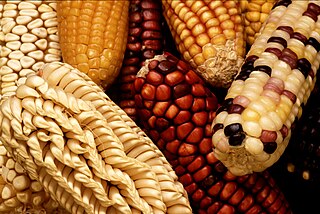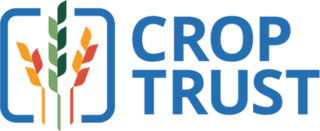
A seed bank stores seeds to preserve genetic diversity; hence it is a type of gene bank. There are many reasons to store seeds. One is to preserve the genes that plant breeders need to increase yield, disease resistance, drought tolerance, nutritional quality, taste, etc. of crops. Another is to forestall loss of genetic diversity in rare or imperiled plant species in an effort to conserve biodiversity ex situ. Many plants that were used centuries ago by humans are used less frequently now; seed banks offer a way to preserve that historical and cultural value. Collections of seeds stored at constant low temperature and low moisture are guarded against loss of genetic resources that are otherwise maintained in situ or in field collections. These alternative "living" collections can be damaged by natural disasters, outbreaks of disease, or war. Seed banks are considered seed libraries, containing valuable information about evolved strategies to combat plant stress, and can be used to create genetically modified versions of existing seeds. The work of seed banks often span decades and even centuries. Most seed banks are publicly funded and seeds are usually available for research that benefits the public.
The International Treaty on Plant Genetic Resources for Food and Agriculture, is a comprehensive international agreement in harmony with the Convention on Biological Diversity, which aims at guaranteeing food security through the conservation, exchange and sustainable use of the world's plant genetic resources for food and agriculture (PGRFA), the fair and equitable benefit sharing arising from its use, as well as the recognition of farmers' rights. It was signed in 2001 in Madrid, and entered into force on 29 June 2004.

CGIAR is a global partnership that unites international organizations engaged in research about food security. CGIAR research aims to reduce rural poverty, increase food security, improve human health and nutrition, and sustainable management of natural resources.

Agricultural biodiversity or agrobiodiversity is a subset of general biodiversity pertaining to agriculture. It can be defined as "the variety and variability of animals, plants and micro-organisms at the genetic, species and ecosystem levels that sustain the ecosystem structures, functions and processes in and around production systems, and that provide food and non-food agricultural products.” It is managed by farmers, pastoralists, fishers and forest dwellers, agrobiodiversity provides stability, adaptability and resilience and constitutes a key element of the livelihood strategies of rural communities throughout the world. Agrobiodiversity is central to sustainable food systems and sustainable diets. The use of agricultural biodiversity can contribute to food security, nutrition security, and livelihood security, and it is critical for climate adaptation and climate mitigation.

In agriculture and gardening, seed saving is the practice of saving seeds or other reproductive material from vegetables, grain, herbs, and flowers for use from year to year for annuals and nuts, tree fruits, and berries for perennials and trees. This is the traditional way farms and gardens were maintained for the last 12,000 years.

Germplasm refers to genetic resources such as seeds, tissues, and DNA sequences that are maintained for the purpose of animal and plant breeding, conservation efforts, agriculture, and other research uses. These resources may take the form of seed collections stored in seed banks, trees growing in nurseries, animal breeding lines maintained in animal breeding programs or gene banks. Germplasm collections can range from collections of wild species to elite, domesticated breeding lines that have undergone extensive human selection. Germplasm collection is important for the maintenance of biological diversity, food security, and conservation efforts.

An heirloom plant, heirloom variety, heritage fruit, or heirloom vegetable is an old cultivar of a plant used for food that is grown and maintained by gardeners and farmers, particularly in isolated communities of the Western world. These were commonly grown during earlier periods in human history, but are not used in modern large-scale agriculture.

The Svalbard Global Seed Vault is a secure backup facility for the world's crop diversity on the Norwegian island of Spitsbergen in the remote Arctic Svalbard archipelago. The Seed Vault provides long-term storage of duplicates of seeds conserved in genebanks around the world. This provides security of the world's food supply against the loss of seeds in genebanks due to mismanagement, accident, equipment failures, funding cuts, war, sabotage, disease and natural disasters. The Seed Vault is managed under terms spelled out in a tripartite agreement among the Norwegian government, the Crop Trust, and the Nordic Genetic Resource Center (NordGen).

A gene bank is a type of biorepository that is designed around the preservation of genetic information. Gene banks are often used for storing the genetic material of species that are endangered or close to extinction. They are also used for the preservation of major crop species and cultivars, in order to preserve crop diversity.

The Crop Trust, officially known as the Global Crop Diversity Trust, is an international nonprofit organization with a secretariat in Bonn, Germany. Its mission is to conserve and make available the world's crop diversity for food security.

Morgan Carrington "Cary" Fowler Jr. is an American agriculturalist and the former executive director of the Crop Trust, currently serving as U.S. Special Envoy for Global Food Security. He is the 2024 World Food Prize laureate.

Bioversity International is a global research-for-development organization that delivers scientific evidence, management practices and policy options to use and safeguard agricultural biodiversity to attain global food- and nutrition security, working with partners in low-income countries in different regions where agricultural biodiversity can contribute to improved nutrition, resilience, productivity and climate change adaptation. In 2019, Bioversity International joined with the International Center for Tropical Agriculture to "deliver research-based solutions that harness agricultural biodiversity and sustainably transform food systems to improve people’s lives".. Both institutions are members of the CGIAR, a global research partnership for a food-secure future.
Crop diversity or crop biodiversity is the variety and variability of crops, plants used in agriculture, including their genetic and phenotypic characteristics. It is a subset of a specific element of agricultural biodiversity. Over the past 50 years, there has been a major decline in two components of crop diversity; genetic diversity within each crop and the number of species commonly grown.
Forest genetic resources or foresttree genetic resources are genetic resources of forest shrub and tree species. Forest genetic resources are essential for forest-depending communities who rely for a substantial part of their livelihoods on timber and non-timber forest products for food security, domestic use and income generation. These resources are also the basis for large-scale wood production in planted forests to satisfy the worldwide need for timber and paper. Genetic resources of several important timber, fruit and other non-timber tree species are conserved ex situ in genebanks or maintained in field collections. Nevertheless, in situ conservation in forests and on farms is in the case of most tree species the most important measure to protect their genetic resources.
Irish Seed Savers Association (ISSA) is an Irish non-governmental organisation founded in 1991. The Irish Seed Savers Association maintains a seed bank with over 600 non-commercially available varieties of seed.
John Trevor Williams was a British plant geneticist who was instrumental in the creation of plant gene banks.
The National Centre for Plant Genetic Resources: Polish Genebank (NCPGR) is a research unit in the Plant Breeding and Acclimatization Institute – National Research Institute. NCPGR is the coordinator and implementer of the National Crop Plant Genetic Resources Protection Programme. The Programme aims to protect the biodiversity of crop plants endangered by genetic erosion in Poland, and is funded by the Ministry of Agriculture. The main tasks include collection of crop and wild plant populations and varieties threatened by genetic erosion, description and evaluation of collected materials, and preservation of their viability and genetic purity. The Programme is an implementation of provisions laid down in international treaties ratified by Poland:

Plant genetic resources describe the variability within plants that comes from human and natural selection over millennia. Their intrinsic value mainly concerns agricultural crops.
The Commission on Genetic Resources for Food and Agriculture of the Food and Agriculture Organization of the United Nations (FAO) is an intergovernmental body that addresses issues specifically related to the management of biodiversity of relevance to food and agriculture. It was established in 1983 as the Commission on Plant Genetic Resources for Food and Agriculture. In 1995, the mandate of the Commission was extended to cover all components of biodiversity for food and agriculture and its name was changed to its current version. Its membership comprises 179 countries and the European Union.

Geoffrey Hawtin OBE is an agricultural scientist and World Food Prize laureate who has served in public institutions working in agricultural biodiversity, plant genetic resources, crop breeding and research management. He was awarded an OBE by Queen Elizabeth II and has been recognized for his career "dedicated to using agriculture as a weapon in the war against poverty in developing countries." He played key roles in the creation of the Svalbard Global Seed Vault and the negotiation of the International Treaty on Plant Genetic Resources. He has headed two CGIAR Research Centers and currently is on the Executive Board of the Crop Trust.












